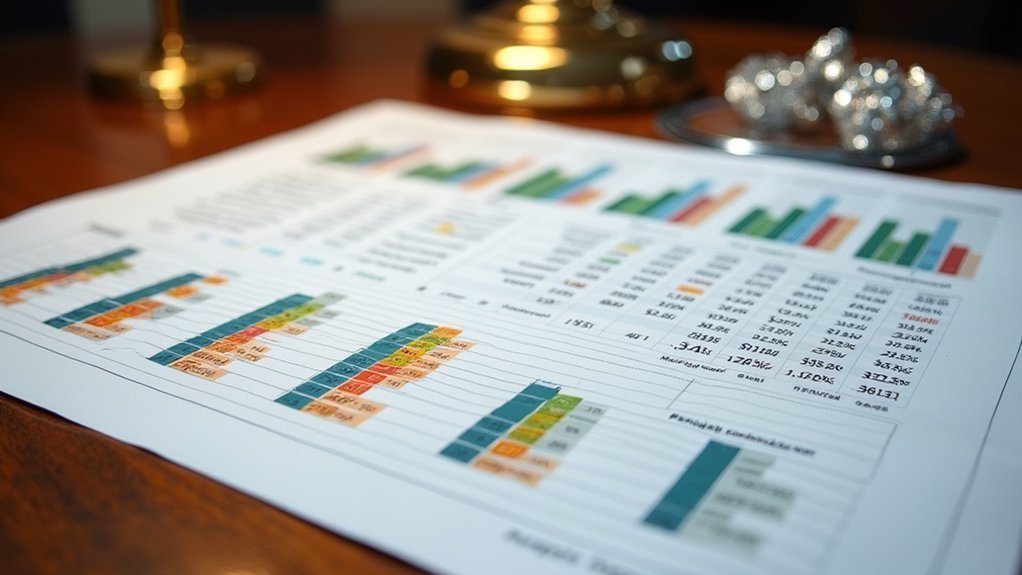You’ll need an extensive financial spreadsheet tracking multiple revenue streams including retail sales, wholesale transactions, custom commissions, and repair services. Calculate your cost of goods sold precisely by including raw materials, labor, import duties, and packaging costs. Monitor key performance indicators like average transaction value and gross margin percentage while forecasting cash flow to prevent shortfalls. Include break-even analysis and investment planning templates to maintain profitable operations and strategic growth opportunities ahead.
Essential Components of Jewelry Business Financial Spreadsheets

Three fundamental financial statements form the backbone of any jewelry business spreadsheet: projected income statements, balance sheets, and cash flow statements.
These components provide you with a thorough overview of your business’s financial health and enable accurate financial projections for future growth.
You’ll need to track multiple revenue streams including retail sales, wholesale transactions, and custom commissions.
This real-time monitoring helps you forecast income more precisely. Additionally, you must document expenses related to rent, utilities, marketing, and salaries for effective budget management.
Your spreadsheet should also integrate key performance indicators like average transaction value and customer acquisition cost.
These performance indicators help you assess business growth potential and make informed decisions that’ll drive profitability and guarantee long-term success.
Revenue Stream Tracking and Projection Methods
When establishing robust revenue projections for your jewelry business, you’ll need to categorize each income source systematically to capture the full scope of your earning potential. Revenue stream tracking involves monitoring retail sales, wholesale transactions, custom commissions, online sales, and repair services. Your financial forecast becomes more accurate when you input average sale prices and estimated units for each category.
Here’s how to optimize your tracking system:
- Calculate cost of goods sold including raw materials and labor to determine true profitability.
- Monitor key performance indicators like average transaction value and customer acquisition cost.
- Update projections regularly to identify seasonal trends and market fluctuations.
This systematic approach helps you allocate revenue effectively toward ongoing expenses while maintaining profitable operations through data-driven decision making.
Cost of Goods Sold Management for Jewelry Operations

The foundation of profitable jewelry operations rests on meticulously managing your cost of goods sold, which encompasses every expense directly tied to creating and delivering your products.
Your COGS includes raw materials like metals and gemstones, production labor from skilled artisans, import duties, taxes, packaging, and shipping costs. These components directly impact your profit margins and require careful tracking.
Effective financial management means calculating each element precisely. When you accurately account for material costs, labor expenses, and additional fees, you’ll determine true gross margins.
This thorough approach enables strategic pricing decisions that protect profitability while remaining competitive.
Monitor your cost of goods sold regularly through detailed spreadsheet tracking. This practice guarantees you maintain healthy margins and identify cost reduction opportunities that strengthen your jewelry business’s financial foundation.
Operating Expense Categories and Budget Allocation
Beyond your direct production costs, numerous operating expenses form the backbone of your jewelry business’s daily operations.
Effective financial planning requires strategic budget allocation across these essential categories to build a successful jewelry business.
Your major operating expenses include:
- Facility and utilities costs – Rent for retail space or workshops, plus electricity and water that fluctuate with operational demands.
- Staff compensation – Salaries and wages for skilled workers, carefully balanced to retain talent while managing payroll expenses.
- Marketing and protection – Advertising investments for customer acquisition and thorough insurance coverage against theft or damages.
You’ll need to allocate significant portions of your budget toward marketing, as it drives sales growth in this competitive industry.
Don’t overlook insurance costs—they’re crucial for protecting your valuable assets and inventory.
Key Performance Indicators for Jewelry Business Success
Tracking specific metrics drives informed decision-making and reveals whether your jewelry business is truly thriving or merely surviving. Your financial projection becomes accurate when you monitor essential key performance indicators that reflect your business health.
Focus on average transaction value to understand customer spending patterns and refine your pricing strategy. Calculate customer acquisition cost to evaluate marketing effectiveness and maximize promotional ROI.
Monitor conversion rates to assess how well you’re transforming visitors into buyers through improved sales tactics. Track inventory turnover rate to optimize stock management and minimize holding costs.
Most importantly, measure your gross margin percentage regularly—this reveals true profitability by comparing sales revenue against cost of goods sold, enabling strategic pricing decisions and effective cost control.
Cash Flow Forecasting and Working Capital Requirements
While monitoring KPIs reveals your jewelry business’s current health, predicting future financial stability requires mastering cash flow forecasting and understanding your working capital needs.
You’ll need to create accurate projections that prevent financial shortfalls and maintain operational liquidity. Your cash conversion cycle directly impacts how quickly you transform inventory into cash, affecting your overall working capital requirements.
To build effective financial forecasting, focus on these essential elements:
- Document detailed expenses to assess accurate working capital requirements for daily operations and inventory purchases.
- Create extensive expense forecasting models that anticipate unexpected costs and seasonal fluctuations.
- Develop structured cash flow statement projections that identify potential challenges before they impact your business.
This systematic approach enables informed investment decisions and sustainable long-term growth.
Break-Even Analysis and Profitability Metrics

You’ll need to calculate your break-even point to determine exactly how many pieces you must sell before turning a profit.
This calculation requires analyzing your fixed costs, variable costs per unit, and selling price to establish the minimum sales volume that covers all expenses.
Once you’ve identified this threshold, you can set realistic profitability targets and adjust your pricing strategy to guarantee sustainable growth.
Break-Even Point Calculation
Since your jewelry business operates with unique cost structures involving precious metals, gemstones, and skilled craftsmanship, calculating your break-even point requires careful consideration of both fixed and variable expenses.
Your jewelry financial model must account for fluctuating material costs and seasonal demand patterns.
To calculate your break-even point effectively, follow these essential steps:
- Identify all fixed costs – Include rent, insurance, equipment payments, and base salaries.
- Calculate variable costs per piece – Factor in materials, packaging, and commission-based labor.
- Determine your average selling price – Consider your product mix and pricing strategy.
Apply the formula: Fixed Costs ÷ (Average Selling Price – Variable Cost per Unit).
This calculation reveals exactly how many pieces you must sell to cover all financial expenses before generating profit.
Profitability Threshold Planning
Once you’ve mastered your break-even calculations, you’ll need to establish a thorough profitability threshold framework that goes beyond simple cost recovery.
Your break-even analysis serves as the foundation, but true profitability planning requires setting targets that generate meaningful returns on your jewelry business investment.
Start by determining your desired profit margin above the break-even point. Calculate multiple threshold scenarios—conservative, moderate, and aggressive—to understand how different sales volumes impact your bottom line.
Your financial planning spreadsheet should track gross margin percentages, operating performance ratios, and profit targets monthly.
Monitor these metrics consistently, updating your thresholds as material costs and market conditions change.
This proactive approach guarantees you’re not just covering costs but building sustainable profitability that supports long-term business growth and reinvestment opportunities.
Investment Planning and Funding Strategy Templates
While launching a jewelry business requires significant upfront capital, investment planning and funding strategy templates provide the roadmap you need to secure adequate financing and allocate resources effectively.
These structured tools help you identify initial capital requirements and outline potential financing sources, from personal savings to investor contributions.
Your startup costs become manageable when you use thorough budget templates that track:
- Raw materials and production expenses – including precious metals, gemstones, and manufacturing equipment
- Marketing and operational costs – covering advertising, insurance, and workspace rental fees
- Revenue projections and funding scenarios – enabling cost-benefit analyses and ROI calculations
These templates promote financial discipline while helping you assess your business model’s viability and set realistic goals based on market research.
Financial Statement Generation and Performance Monitoring

You’ll generate thorough financial statements automatically through the Jewelry Financial Model’s provisional balance sheet, cash flow statement, and income statement capabilities.
When you modify your business assumptions, the model updates all financial tables and formulas instantly, eliminating manual calculations and ensuring real-time accuracy.
You can monitor critical KPIs like average transaction value, customer acquisition cost, and gross margin percentage to track your jewelry business’s performance against industry benchmarks.
Automated Statement Creation
Although managing financial statements manually can consume countless hours and introduce costly errors, automated statement creation transforms this burdensome task into an effortless process.
Your jewelry store business can now generate professional financial documents instantly through sophisticated automation that handles complex calculations and formatting.
The automated system delivers three critical advantages:
- Instant Document Generation – Your Profit and Loss, Balance Sheet, and Cash Flow Statements update automatically when you modify any input data.
- Error Elimination – Built-in verification systems guarantee compliance with accounting standards and catch calculation mistakes before they impact your financial model structure.
- Real-Time Updates – Changes to assumptions immediately reflect across all connected statements, maintaining consistency throughout your business planning process.
This automation empowers you to focus on strategic decisions rather than tedious spreadsheet maintenance.
Real-Time Performance Tracking
Because your jewelry business operates in an environment where market conditions and customer preferences shift rapidly, you need immediate visibility into your financial performance rather than waiting for month-end reports.
This financial management tool delivers real-time tracking of critical metrics that determine your success. You’ll monitor key performance indicators like gross margin percentage, average transaction value, and customer acquisition cost directly within your spreadsheet.
The system automatically updates as you modify assumptions, ensuring your jewelry business data remains current and actionable. Cash flow metrics including your conversion cycle and burn rate provide instant insights for inventory and spending decisions.
Whether you’re using Excel or Google Sheets, you’ll gain thorough visibility into operational efficiency without complex financial expertise.
Frequently Asked Questions
How to Make an Excel Sheet for Jewelry Business?
Create categories for inventory, sales, and expenses. Use separate sheets for financial statements. Apply formulas for calculations, color-code profitable items, and update regularly with accurate data for effective business tracking.
How to Write a Business Plan for a Jewelry Business?
You’ll write your jewelry business plan by starting with an executive summary, then conducting market research, defining your target audience, analyzing competitors, outlining marketing strategies, and creating detailed financial projections.
What Is the Best Business Structure for a Jewelry Business?
You’ll likely find an LLC works best for your jewelry business since it protects your personal assets from liability while offering tax flexibility and simpler compliance requirements than corporations.
How Do I Start a Successful Jewelry Business?
You’ll need thorough market research, a solid business plan, adequate funding ($3K-$30K), strong online presence, and effective marketing strategies. Focus on understanding your target audience, analyzing competitors, and building compelling brand identity to succeed.
In Summary
You’ll transform your jewelry business with these extensive financial planning spreadsheets. Track your revenue streams, manage costs effectively, and monitor key performance indicators that drive profitability. Use cash flow forecasting to maintain healthy working capital while conducting regular break-even analyses. Don’t forget to incorporate investment planning templates for future growth. With consistent monitoring and data-driven decisions, you’ll build a financially sustainable jewelry business that thrives in competitive markets.





Leave a Reply